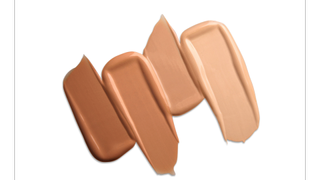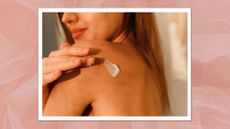Why you should try going foundation free one day a week
Totally addicted to base? Wean yourself on to a foundation free day and your skin will thank you for it


This is not going to be one of those touchy-feely articles about how we all need to chuck out our best foundation and learn to love our naked, make-up-free selves just as we are.*
There’s no doubt that feeling confident foundation-free is a great thing, but that’s not what we’ll be talking about today – because if you have any sort of chronic skin issue, such as melasma and pigmentation, rosacea or adult acne, foundation can be the difference between feeling happy to leave the house or pulling a sickie on your best friend’s birthday because you’ve flared up and just can’t face it. The path to skin acceptance is thornier for some than others, and if foundation can help smooth things out a bit, then great, that’s what it’s there for.
So, instead of the emotional pep talk, I’m planning to appeal to your left brain with some hard facts on why a weekly foundation-free day could pay dividends in the long run. Let’s talk formulations and comedogenic properties; let’s dive into the often asserted yet largely misinformed notion of “letting skin breathe”. Yep, this is what once would have been called The Science Bit. Buckle up, we’ll begin with the bad news on ingredients.
*if that is what you want, read about how I swapped bare faced no make-up make-up for an actual bare face. All the feels.
Is going foundation free better for my skin?
Well… It’s complicated. On the battlefield of skin heroes and villains, with my beloved retinol on one side and heinous UV rays at the other, most foundations would be plonked right in the middle ground.
The crux of the matter is not that all foundations are bad for your skin, but that, generally speaking, people who are drawn to heavy, not-so-skin-friendly bases and continuously wearing said bases are the people whose faces will probably not be happy about it.
Here’s an example of this cosmetic catch 22. Many medium to high coverage foundations for oily skin – ie the ones you would very likely buy to cover adult acne – are silicone-based. In theory, this makes sense. Silicones help highly pigmented formulations maintain an elegant, slippy texture, smooth over enlarged pores and help the product grip on to skin.
The flipside of that slippy, grippy layer is that it can trap whatever’s beneath it (usually grime or sebum), which then builds up in the pores. This is also known as “occluding” the pores, which is as unwelcome a side effect as you can imagine with acne-prone or reactive skin.
What comedogenic foundation does to your skin
This occluding effect also applies to mineral oils and various other ingredients, including coconut derivatives like alkanes and acrylics, which are sometimes included in stick foundations.
These pore-clogging ingredients, along with scores of others, are known as comedogenic. They are also the last thing you’d want to rub all over your skin every day if congestion and breakouts are what you’re wearing foundation for in the first place.
On that note, a word on the persistent rumour that wearing foundation stops skin “breathing”: I’m fairly certain when people trot that old chestnut out it’s this occluding effect they are referring to. Just to be clear, skin doesn’t have a respiratory system, therefore breathing really isn’t a priority (or a physical possibility) for that particular organ. Same goes for nails FYI.
How foundation can affect rosacea
Another skin type that might have a love-hate relationship with foundation is rosacea. This more-common-than-you-think condition causes redness, broken capillaries and sometimes cystic pustules that hardcore base makes light work of disguising.
In high coverage formulas artificial fragrance is frustratingly ubiquitous and can trigger a flare-up. As can bismuth oxychloride, a mineral often found in powder foundations designed for sensitive skin, which over time can cause extreme irritation, itching and even cystic-acne breakouts.
This all sounds scary, but I did warn there was some bad news. Maybe it seems like irrelevant news if you’re lucky enough to have relatively well-behaved skin. But the point is, along with all the nice things they boast about on the box, foundations more often than not contain things that aren’t quite so welcome in order to do their job. If they didn’t, they’d be skincare rather than make-up, which brings me to my next point...

Are foundations with skincare ingredients better?
And so to the good news: Most decent foundations these days include skincare ingredients along with the usual pigment suspended in a carrier liquid of oil, water or silicone. The 90s tinted moisturiser trend repackaged and recycled into the mid-2010s BB cream boom brought us formulas claiming to be more skincare than make-up. Surely, you may think, if my foundation is hydrating with hyaluronic acid and protecting with antioxidants and SPF, then it can’t be doing more harm than good?
You wouldn’t be wrong about the sun protection. In fact, even if your foundation doesn’t boast an SPF rating, it probably contains titanium dioxide. This UV-absorbing mineral is widely used in sunscreens but also happens to be so good at thickening and adding opacity to cosmetics that chances are, your foundation has a drop or two of it in there.
And yes, “chances are” is an unscientific assertion for The Science Bit. But just know that in the process of writing this I grabbed six foundations at random from my beauty testing shelf and, sure enough, five contained titanium dioxide. Trust me when I say I’ve seen clinical trial results based on less.
This is not to say one tiny pump of foundation spread across a 6in square surface area constitutes adequate defence (wear sunscreen, people – you heard the Baz Luhrmann song). But, working on the “something’s better than nothing” model, your foundation is very likely providing something in the way of fending off UV rays on a daily basis.
What about hydrating ingredients?
The majority of moisture-boosting foundations do so with hyaluronic acid (HA), a much-loved active that draws water into the top layers of the skin and keeps it locked there. This makes it an excellent surface-level skin plumper and soother, but what HA can’t do is the long-term, deep-layer work of your skincare actives, like retinol, skincare acids or vitamin C.
Speaking of which, if your foundation boasts about containing vitamin C, it won’t be any great shakes. This gold-standard antioxidant is a delicate little diva. No light, no air, no heat, concentrations of 10%+ only please and if any oxidisation does occur, she’ll turn a murky shade of old dishwater brown. It’s also expensive to formulate well, so in cosmetics will very likely be included in such low doses as to be pretty much redundant. Less erratic antioxidants like vitamin E and green tea are a better bet for a gentle nod to environmental protection, but consider it that – a nod.
Skincare ingredients can work hard to balance out a formula, but ultimately your foundation is not going to improve your skin. That’s what whipping all your make-up off and smothering on a serum is for. Speaking of which…
Why I think you should go foundation free
You’ve had the good, the bad and now here comes the ugly. Ingredients aside, one compelling reason to go foundation-free at least one day a week is this: Grime.
Firstly, I’m talking the grime, old pigment and bacteria that slowly builds up on your face as you apply foundation over foundation and very possibly don’t quite cleanse every scrap of it off. The thing is, even if you’re a good cleanser – a proper “warm water and flannel, one wash for make-up and another one for your skin” double cleanser – chances are something gets left behind.
Remember that yikes moment in early 2020 when the government explained the lengthy multifactorial ritual required to wash our hands effectively? I doubt even the most devoted skincare zealots manage this twice in a row every single night on their faces – I know I don’t. So, having one day a week to deep-clean and dislodge all this grime hanging around in your pores without loading anything extra on can make an enormous difference to your skin’s quality and ability to absorb skincare.
Next grimy reason to take a break from foundation is not the foundation itself but your make-up brushes, because – admit it – they don’t get washed all that often, do they? A recent study by Cosmetify.com found that one in four UK women had never cleaned them, and of those that had, one-third only did so every six months. I won’t presume to know which category you fall into, but you don’t need me to tell you that a daily sweep of grime, bacteria and who knows what else ain’t the route to clear, happy, healthy skin.
Take just one day off from adding to the build-up and use it to wash and dry your foundation brush, seeing as you won’t be needing it, and I promise your skin will thank you for it. You’ll also eradicate those intermittent “I should really wash that makeup brush” guilt pangs from your life. Bonus.
Feeling tempted to give it a go?
If i didn’t get you with the ingredient facts, maybe the dirty home truths have done the trick. For ultimate satisfaction, I recommend Lazy Sundays, with nowhere to go and no one to see, as the ultimate foundation-free day. Give your face a good wash, maybe chuck on a purifying mask, too, and wash your foundation brush (or all your brushes – can’t hurt!).
Consider it a hard reset, ready for the week ahead. Along with washing your bedding, posting a birthday card and roasting chicken with enough for leftovers, few Sunday activities will make you feel so much like a woman in control of her life.
Oh, and your skin will really truly thank you for it – but I think I’ve said that already.
Sign up for the woman&home newsletter
Sign up to our free daily email for the latest royal and entertainment news, interesting opinion, expert advice on styling and beauty trends, and no-nonsense guides to the health and wellness questions you want answered.

As woman&home's Beauty Channel Editor, Fiona Mckim loves to share her 15+ years of industry intel on womanandhome.com and Instagram (@fionamckim if you like hair experiments and cute shih-tzus). After interning at ELLE, Fiona joined woman&home as Assistant Beauty Editor in 2013 under industry legend Jo GB, who taught her to understand ingredients and take a cynical approach to marketing claims. She has since covered every corner of the industry, interviewing dermatologists and celebrities from Davina McCall to Dame Joan Collins, reporting backstage at London Fashion Week and judging the w&h Beauty Awards.
-
 I visited 63 countries collecting local beauty secrets - these are the 4 ingredients you need to try
I visited 63 countries collecting local beauty secrets - these are the 4 ingredients you need to tryA beauty editor turned travel writer shares her must-try discoveries, from calming Turkish rose to fragrant Malaysian sandalwood
By Lydia Swinscoe Published
-
 Want to know how to fake tan your back without bending like a pretzel? Three tanning experts explain
Want to know how to fake tan your back without bending like a pretzel? Three tanning experts explainYou don't need to be a contortionist to tan your own back, you just need these tips
By Jess Beech Published